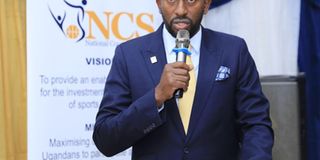Negligence a big worry for Uganda’s doping fight

National Council of Sports (NCS) chairman Ambrose Tashobya, believes Uganda's biggest problem as far as the fight against doping is concerned is negligence. PHOTO/ COURTESY
What you need to know:
A clear example is of Uganda’s weightlifters Mubarak Kivumbi and Godfrey Baligeya who missed the Commonwealth Games because they changed a training venue from one they had told the authorities they would be.
National Council of Sports (NCS) chairman Ambrose Tashobya, believes Uganda's biggest problem as far as the fight against doping is concerned is “negligence.”
Tashobya was making these remarks at Sheraton Hotel during the opening ceremony of the Africa Zone V Regional Anti-Doping Project training of trainers programme on Wednesday.
“Fortunately, we are not at a high level of doping like Russia or the case of (cyclist) Lance Armstrong, maybe because that requires very huge resources,” Tashobya said at the start of three-day training that has attracted participants from 12 countries.
“But we need to beware. Our biggest issue is negligence, where someone for example fills a form and thinks they are doing so for the sake yet it is a commitment,” Tashobya added.
A clear example is of Uganda’s weightlifters Mubarak Kivumbi and Godfrey Baligeya who missed the Commonwealth Games because they changed a training venue from one they had told the authorities they would be.
Uganda Olympic Committee (UOC) general secretary Beatrice Ayikoru also said that the other thing that makes this fight “very difficult is the diverse nature of stakeholders.”
“It is not only about sharing information with athletes and coaches but with doctors, pharmacists and physical educators who deal with athletes.”
Upping education capacity
Aya Nakitanda, an Olympian and now at National Anti-Doping Organization (Nado), retaliated that the World Agency (Wada) classifies Uganda as one of the lowest risk countries but there are still concerns as the classification of sports is heterogeneous.
“Athletics for example is in a category of moderate risk. We have World and Olympic champions among others but also the earnings are high.
Those high incomes can be an incentive (for athletes to dope). But we (Nado) have been working hard to educate athletes and federation leaders.
However, the education capacity is low and we now want to do more. Part of this course is to have our educators go to federations and teach more people, who will in turn educate the athletes on the risks of doping.




